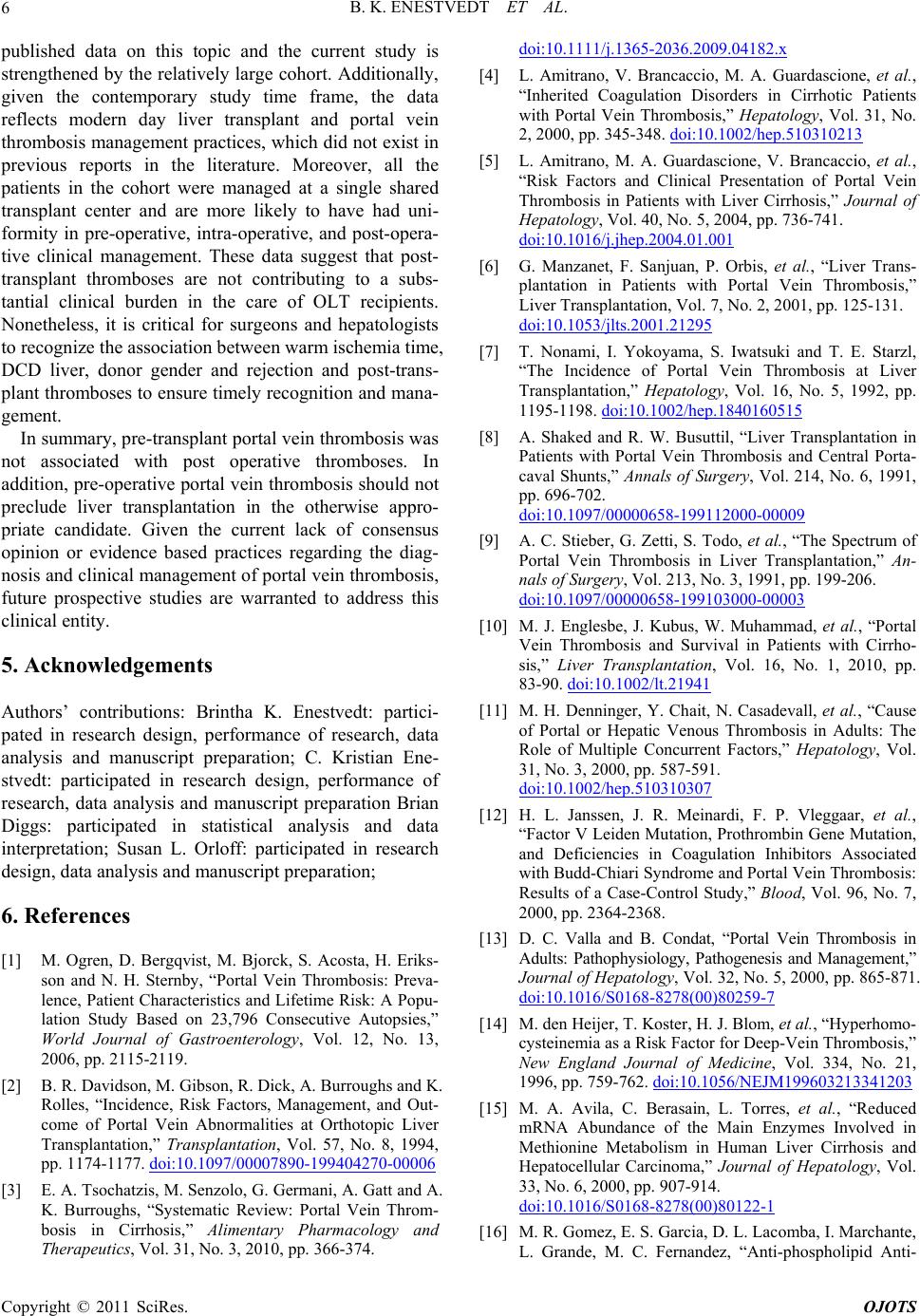
B. K. ENESTVEDT ET AL.
6
published data on this topic and the current study is
strengthened by the relatively large cohort. Additionally,
given the contemporary study time frame, the data
reflects modern day liver transplant and portal vein
thrombosis management practices, which did not exist in
previous reports in the literature. Moreover, all the
patients in the cohort were managed at a single shared
transplant center and are more likely to have had uni-
formity in pre-operative, intra-operative, and post-opera-
tive clinical management. These data suggest that post-
transplant thromboses are not contributing to a subs-
tantial clinical burden in the care of OLT recipients.
Nonetheless, it is critical for surgeons and hepatologists
to recognize the association between warm ischemia time,
DCD liver, donor gender and rejection and post-trans-
plant thromboses to ensure timely recognition and mana-
gement.
In summary, pre-transplant portal vein thrombosis was
not associated with post operative thromboses. In
addition, pre-operative portal vein thrombosis should not
preclude liver transplantation in the otherwise appro-
priate candidate. Given the current lack of consensus
opinion or evidence based practices regarding the diag-
nosis and clinical management of portal vein thrombosis,
future prospective studies are warranted to address this
clinical entity.
5. Acknowledgements
Authors’ contributions: Brintha K. Enestvedt: partici-
pated in research design, performance of research, data
analysis and manuscript preparation; C. Kristian Ene-
stvedt: participated in research design, performance of
research, data analysis and manuscript preparation Brian
Diggs: participated in statistical analysis and data
interpretation; Susan L. Orloff: participated in research
design, data analysis and manuscript preparation;
6. References
[1] M. Ogren, D. Bergqvist, M. Bjorck, S. Acosta, H. Eriks-
son and N. H. Sternby, “Portal Vein Thrombosis: Preva-
lence, Patient Characteristics and Lifetime Risk: A Popu-
lation Study Based on 23,796 Consecutive Autopsies,”
World Journal of Gastroenterology, Vol. 12, No. 13,
2006, pp. 2115-2119.
[2] B. R. Davidson, M. Gibson, R. Dick, A. Burroughs and K.
Rolles, “Incidence, Risk Factors, Management, and Out-
come of Portal Vein Abnormalities at Orthotopic Liver
Transplantation,” Transplantation, Vol. 57, No. 8, 1994,
pp. 1174-1177. doi:10.1097/00007890-199404270-00006
[3] E. A. Tsochatzis, M. Senzolo, G. Germani, A. Gatt and A.
K. Burroughs, “Systematic Review: Portal Vein Throm-
bosis in Cirrhosis,” Alimentary Pharmacology and
Therapeutics, Vol. 31, No. 3, 2010, pp. 366-374.
doi:10.1111/j.1365-2036.2009.04182.x
[4] L. Amitrano, V. Brancaccio, M. A. Guardascione, et al.,
“Inherited Coagulation Disorders in Cirrhotic Patients
with Portal Vein Thrombosis,” Hepatology, Vol. 31, No.
2, 2000, pp. 345-348. doi:10.1002/hep.510310213
[5] L. Amitrano, M. A. Guardascione, V. Brancaccio, et al.,
“Risk Factors and Clinical Presentation of Portal Vein
Thrombosis in Patients with Liver Cirrhosis,” Journal of
Hepatology, Vol. 40, No. 5, 2004, pp. 736-741.
doi:10.1016/j.jhep.2004.01.001
[6] G. Manzanet, F. Sanjuan, P. Orbis, et al., “Liver Trans-
plantation in Patients with Portal Vein Thrombosis,”
Liver Transplantation, Vol. 7, No. 2, 2001, pp. 125-131.
doi:10.1053/jlts.2001.21295
[7] T. Nonami, I. Yokoyama, S. Iwatsuki and T. E. Starzl,
“The Incidence of Portal Vein Thrombosis at Liver
Transplantation,” Hepatology, Vol. 16, No. 5, 1992, pp.
1195-1198. doi:10.1002/hep.1840160515
[8] A. Shaked and R. W. Busuttil, “Liver Transplantation in
Patients with Portal Vein Thrombosis and Central Porta-
caval Shunts,” Annals of Surgery, Vol. 214, No. 6, 1991,
pp. 696-702.
doi:10.1097/00000658-199112000-00009
[9] A. C. Stieber, G. Zetti, S. Todo, et al., “The Spectrum of
Portal Vein Thrombosis in Liver Transplantation,” An-
nals of Surgery, Vol. 213, No. 3, 1991, pp. 199-206.
doi:10.1097/00000658-199103000-00003
[10] M. J. Englesbe, J. Kubus, W. Muhammad, et al., “Portal
Vein Thrombosis and Survival in Patients with Cirrho-
sis,” Liver Transplantation, Vol. 16, No. 1, 2010, pp.
83-90. doi:10.1002/lt.21941
[11] M. H. Denninger, Y. Chait, N. Casadevall, et al., “Cause
of Portal or Hepatic Venous Thrombosis in Adults: The
Role of Multiple Concurrent Factors,” Hepatology, Vol.
31, No. 3, 2000, pp. 587-591.
doi:10.1002/hep.510310307
[12] H. L. Janssen, J. R. Meinardi, F. P. Vleggaar, et al.,
“Factor V Leiden Mutation, Prothrombin Gene Mutation,
and Deficiencies in Coagulation Inhibitors Associated
with Budd-Chiari Syndrome and Portal Vein Thrombosis:
Results of a Case-Control Study,” Blood, Vol. 96, No. 7,
2000, pp. 2364-2368.
[13] D. C. Valla and B. Condat, “Portal Vein Thrombosis in
Adults: Pathophysiology, Pathogenesis and Management,”
Journal of Hepatology, Vol. 32, No. 5, 2000, pp. 865-871.
doi:10.1016/S0168-8278(00)80259-7
[14] M. den Heijer, T. Koster, H. J. Blom, et al., “Hyperhomo-
cysteinemia as a Risk Factor for Deep-Vein Thrombosis,”
New England Journal of Medicine, Vol. 334, No. 21,
1996, pp. 759-762. doi:10.1056/NEJM199603213341203
[15] M. A. Avila, C. Berasain, L. Torres, et al., “Reduced
mRNA Abundance of the Main Enzymes Involved in
Methionine Metabolism in Human Liver Cirrhosis and
Hepatocellular Carcinoma,” Journal of Hepatology, Vol.
33, No. 6, 2000, pp. 907-914.
doi:10.1016/S0168-8278(00)80122-1
[16] M. R. Gomez, E. S. Garcia, D. L. Lacomba, I. Marchante,
L. Grande, M. C. Fernandez, “Anti-phospholipid Anti-
Copyright © 2011 SciRes. OJOTS